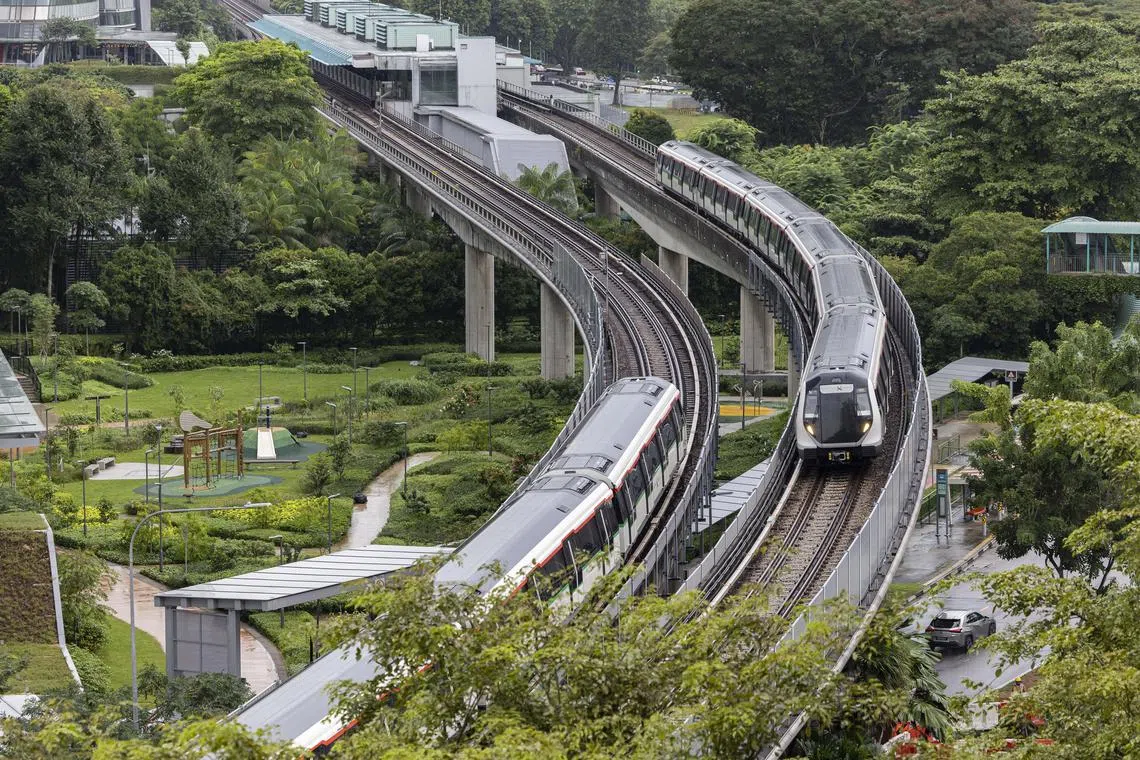Two new MRT lines under study; Jurong Region Line extension in West Coast to proceed
Sign up now: Get ST's newsletters delivered to your inbox

In the nearer term, Mr Chee Hong Tat said new MRT stations or lines will be added here every year from now until the end of the decade.
ST PHOTO: BRIAN TEO
Follow topic:
SINGAPORE – A potential new rail line that could serve areas in Singapore’s west and north-west, such as Tengah, Bukit Batok, Queensway and Bukit Merah, is being studied for its feasibility.
Tentatively called the Tengah Line, it is one of two possible MRT lines the Government is looking to build as part of the next bound of its rail expansion.
Transport Minister Chee Hong Tat laid out these plans during the debate on his ministry’s budget on March 5.
The other potential rail line, tentatively called the Seletar Line, has been under study since 2019.
“I hope it could also go through some parts of Toa Payoh,” Mr Chee added.
He said early assessments by the Land Transport Authority (LTA) are that the proposed Tengah and Seletar lines could meet at the Greater Southern Waterfront. Feasibility studies will thus look into the possibility of combining the two lines into a single line.
If both lines are found to be workable, up to 10 MRT lines could be criss-crossing the island in the 2040s, up from six today.
Meanwhile, a proposal to extend the Jurong Region Line (JRL) southwards to join the Circle Line (CCL) has been given the go-ahead, a decade after it was mooted, Mr Chee announced.
Called the West Coast Extension,
The plan is to extend the JRL further from West Coast station to connect with the CCL at Kent Ridge station by the early 2040s.
Besides supporting future developments, Mr Chee said the West Coast Extension will shave up to 20 minutes off journeys from western Singapore to the city centre.
It will also add to the overall resilience of the rail network by providing an alternative travel option.
Mooted in 2015, the initial plan for the extension was to possibly extend the JRL to join the CCL at Haw Par Villa station.
However, Kent Ridge was found to be a more optimal connection point after assessing factors such as projected transport demand and future developments

Discussions about the need for such an extension were reignited after a massive East-West Line breakdown in September 2024
LTA said the part of the extension between Pandan Reservoir and West Coast stations will be above ground. But whether the rest of it will be above or underground will depend on further feasibility studies.
On the proposed Tengah and Seletar lines, Mr Chee said they can be expected to be completed in phases from the 2040s, if studies confirm that they are feasible.
“It will benefit more than 400,000 households, who will be within a 10-minute walk from this new combined line,” he added.
In response to queries, LTA said it is premature to give cost estimates as the new rail projects are still at an early stage.
Future developments
Plans for the Seletar Line were announced in 2019 as part of the Land Transport Master Plan 2040. LTA had said then that the potential new line, if built, could cut commutes by up to 40 minutes and relieve increasing travel demand in the north-east.
The Greater Southern Waterfront, where the Seletar and Tengah lines could pass through, is a 2,000ha area of land that has been earmarked for future redevelopment.
Twice the size of Punggol, it stretches from Marina East to Pasir Panjang. The first Build-to-Order project there, which will yield around 6,000 Housing Board flats
In the nearer term, Mr Chee said new MRT stations or lines will be added here every year from now until the end of the decade.
The JRL – Singapore’s seventh MRT line – is expected to open in phases from 2027 to 2029.
Singapore’s eighth and longest rail line, the CRL, is expected to open progressively from 2030, connecting major hubs such as the Jurong Lake District, Punggol Digital District and the Changi region.
Noting that rail projects require careful planning, Mr Chee said economies that face persistent budget deficits would not have the fiscal resources to roll out such long-term and large-scale works.
“It also requires political stability, as well as a strong government which can plan long term, and have the ability and resources to turn these plans into reality, because the plans will span multiple terms of government,” he added.
Station rejuvenation
Mr Chee on March 5 also unveiled a multi-year plan to revitalise existing stations on the North-South and East-West Lines (NSEWL).
The upgrades, which could range from platform extensions to more entrances, lifts and covered linkways, are aimed at improving the passenger experience and accommodating growing ridership on Singapore’s two oldest rail lines.
“We’ll review the upgrades required for each station, tailored to the station’s ridership, footprint, typology and surrounding developments,” Mr Chee said.
Yishun MRT station, opened in 1988, will be the pilot project for the rejuvenation programme as it is expected to become even busier with developments in the area.
Separately, work is being done to improve NSEWL stations with high foot traffic, such as City Hall and Raffles Place, by installing new lighting and air-conditioning systems, for instance.
Six NSEWL stations – Choa Chu Kang, Boon Lay, Jurong East, Pasir Ris, Ang Mo Kio and Clementi – are also getting facelifts as part of broader works to prepare them to become new interchanges with the JRL and CRL.
By 2027, a new concourse retail street is expected to add vibrancy to Choa Chu Kang station. In Boon Lay, the EWL platform will be extended, and a new lift and escalator will be added to the station concourse.
Mr Chee said the aim is for LTA to better integrate human-centric design with its engineering expertise to make key public transport nodes more user-friendly, comfortable and convenient.
Acknowledging that there is room for improvement on this front, he said his ministry and LTA will learn from best practices, both locally and abroad.
LTA will also set aside an experimentation fund to develop ideas with passengers.
However, given the many interconnected elements that form the MRT system, maintaining rail reliability will become more challenging as the network expands, Mr Chee added.
Hence, up to $1 billion in additional government funds will be invested over the next five years to improve the management of rail assets and upgrade the 7,000-strong rail workforce.
Mr Chee said the new funding builds on the existing rail financing framework, where LTA is in charge of buying and replacing assets, and the operators are responsible for maintaining them.
The money, which will be invested in new capabilities and technologies, will allow parts and sub-systems to be replaced in a more timely, targeted and proactive manner.
“LTA will determine, based on the condition of each asset, whether maintenance needs to be stepped up by our operators… whether the asset needs to be replaced early, or if it can have its service life extended,” he added.
“This will enable LTA and the operators to achieve high reliability standards, while keeping a tight control on maintenance and asset replacement costs, which will benefit commuters and taxpayers.”
Kok Yufeng is a transport correspondent at The Straits Times.


